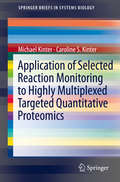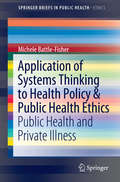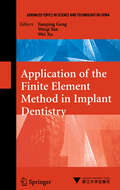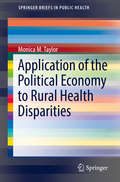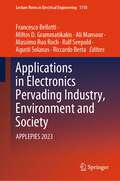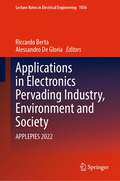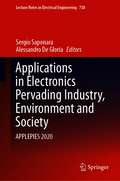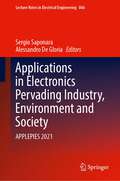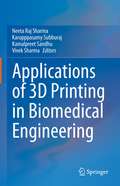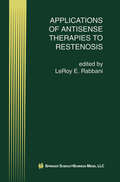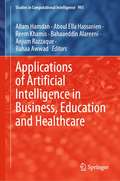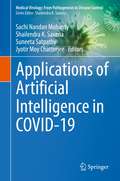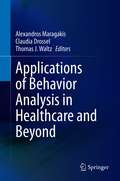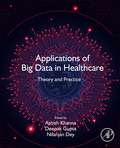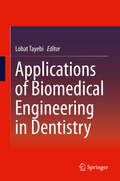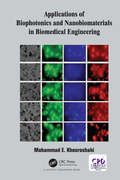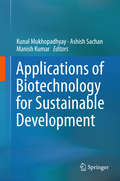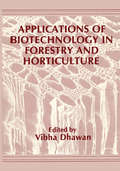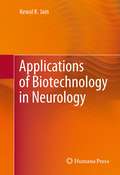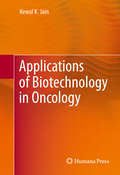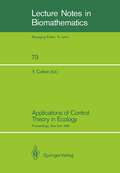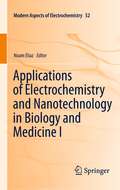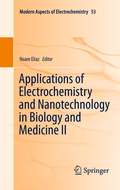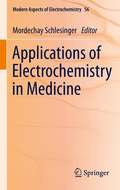- Table View
- List View
Application of Selected Reaction Monitoring to Highly Multiplexed Targeted Quantitative Proteomics: A Replacement for Western Blot Analysis (SpringerBriefs in Systems Biology)
by Michael Kinter Caroline S. KinterA key experiment in biomedical research is monitoring the expression of different proteins in order to detect changes that occur in biological systems under different experimental conditions. The method that is most widely used is the Western blot analysis. While Western blot is a workhorse in laboratories studying protein expression and has several advantages, it also has a number of significant limitations. In particular, the method is semi-quantitative with limited dynamic range. Western blot focuses on a single protein per sample with only a small number of representative samples analyzed in an experiment. New quantitative tools have been needed for some time to at least supplement, & possibly replace, the Western blot. Mass spectrometric methods have begun to compete with Western blot for routine quantitative analyses of proteins. One of these methods is based on the tandem mass spectrometry technique of selected reaction monitoring (SRM), which is also called multiple reaction monitoring (MRM). Selected reaction monitoring is actually an older tandem mass spectrometry technique, first described in the late 70s, that is widely utilized in the quantitative analysis of small molecules like drugs & metabolites. The use of selected reaction monitoring for the quantitative analysis of proteins has a number of advantages. Most importantly, it is fundamentally quantitative with a wide dynamic range. The output of the analysis is a numerical result that can range over several orders of magnitude. Other advantages include sufficient specificity & sensitivity to detect low abundance proteins in complex mixtures. Finally, selected reaction monitoring can be multiplexed to allow the quantitative analysis of relatively large numbers of proteins in a single sample in a single experiment. This Brief will explain both the theoretical & experimental details of the selected reaction monitoring experiment as it is applied to proteins.
Application of Systems Thinking to Health Policy & Public Health Ethics: Public Health and Private Illness (SpringerBriefs in Public Health #0)
by Michele Battle-FisherThis book looks at health policy through the lens of public versus private: population health versus the somatic, social, or emotional experiences of a patient. Rather than presenting policy/ethics as overly technical, this book takes a novel approach of framing public and private health in terms of political philosophy, ethics, and popular examples. Each chapter ties back to the general ethics or political literature as applicable, which are not customarily parts of the current public health curriculum. The author's work on the Orgcomplexity blog has touched on this subject by systemically exploring public policy issues, and the tone of this book mimics the blog with an extension of the arguments.
Application of the Finite Element Method in Implant Dentistry (Advanced Topics in Science and Technology in China)
by Jianping Geng Weiqi Yan Wei XuThis book creates the theoretical foundation that novices need to perform the finite element method in implant dentistry. It shows how both the implant dentist and the designer can benefit from finite element analysis. The authors explain the theory and math of the finite element method. Then, you get practical applications alongside discussions of the critical issues in using finite element analysis for dental implant design.
Application of the Political Economy to Rural Health Disparities (SpringerBriefs in Public Health)
by Monica M. TaylorThis thought-provoking monograph analyzes the longstanding political and economic structures underlying entrenched health inequities in rural areas worldwide. Bypassing familiar data on the subject, it critiques existing approaches to why core social determinants of health are underrepresented in rural communities, and synthesizes knowledge from health behaviors to spatial politics to make creative, equitable suggestions for intervention. The author reviews classic economic and current sociopolitical theory to pinpoint governments’ decision-making processes behind resource allocation as they translate into poor service access, service quality, and health outcomes. In reply, corrective policy measures are recommended to address these conditions at the root-cause level, in keeping with global goals of improved health for all. Included in the coverage: · Rural health disparities: the political economy. · Rural health disparities: the economic argument. · Social disorganization in rural communities. · Rural health disparities and social disorder: public policy responses. · The political economy: an era of institutional cynicism? With its forceful argument for dealing with a growing but often invisible crisis, Application of the Political Economy to Rural Health Disparities makes a significant text for graduate and undergraduate programs in public and international affairs, planning and public policy, public health, public administration, and economics. Public health and advocacy organizations will also benefit from the book’s vision.
Applications in Electronics Pervading Industry, Environment and Society: APPLEPIES 2023 (Lecture Notes in Electrical Engineering #1110)
by Francesco Bellotti Miltos D. Grammatikakis Ali Mansour Massimo Ruo Roch Ralf Seepold Agusti Solanas Riccardo BertaThis book provides a thorough overview of cutting-edge research on electronics applications relevant to industry, the environment, and society at large. It covers a broad spectrum of application domains, from automotive to space and from health to security, while devoting special attention to the use of embedded devices and sensors for imaging, communication, and control. The book is based on the 2023 ApplePies Conference, held in Genoa, Italy, in September 2023, which brought together researchers and stakeholders to consider the most significant current trends in the field of applied electronics and to debate visions for the future. Areas addressed by the conference included information communication technology; biotechnology and biomedical imaging; space; secure, clean, and efficient energy; the environment; and smart, green, and integrated transport. As electronics technology continues to develop apace, constantly meeting previously unthinkable targets, further attention needs to be directed toward the electronics applications and the development of systems that facilitate human activities. This book, written by industrial and academic professionals, represents a valuable contribution in this endeavor.
Applications in Electronics Pervading Industry, Environment and Society: APPLEPIES 2022 (Lecture Notes in Electrical Engineering #1036)
by Riccardo Berta Alessandro De GloriaThis book provides a thorough overview of cutting-edge research on electronics applications relevant to industry, the environment, and society at large. It covers a broad spectrum of application domains, from automotive to space and from health to security, while devoting special attention to the use of embedded devices and sensors for imaging, communication and control. The book is based on the 2022 ApplePies Conference, held in Genoa, Italy in September 2022, which brought together researchers and stakeholders to consider the most significant current trends in the field of applied electronics and to debate visions for the future. Areas addressed by the conference included information communication technology; biotechnology and biomedical imaging; space; secure, clean and efficient energy; the environment; and smart, green and integrated transport. As electronics technology continues to develop apace, constantly meeting previously unthinkable targets, further attention needs to be directed toward the electronics applications and the development of systems that facilitate human activities. This book, written by industrial and academic professionals, represents a valuable contribution in this endeavor.
Applications in Electronics Pervading Industry, Environment and Society: APPLEPIES 2020 (Lecture Notes in Electrical Engineering #738)
by Sergio Saponara Alessandro De GloriaThis book provides a thorough overview of cutting-edge research on electronics applications relevant to industry, the environment, and society at large. It covers a broad spectrum of application domains, from automotive to space and from health to security, while devoting special attention to the use of embedded devices and sensors for imaging, communication and control. The book is based on the 2020 ApplePies Conference, held online in November 2020, which brought together researchers and stakeholders to consider the most significant current trends in the field of applied electronics and to debate visions for the future. Areas addressed by the conference included information communication technology; biotechnology and biomedical imaging; space; secure, clean and efficient energy; the environment; and smart, green and integrated transport. As electronics technology continues to develop apace, constantly meeting previously unthinkable targets, further attention needs to be directed toward the electronics applications and the development of systems that facilitate human activities. This book, written by industrial and academic professionals, represents a valuable contribution in this endeavor.
Applications in Electronics Pervading Industry, Environment and Society: APPLEPIES 2021 (Lecture Notes in Electrical Engineering #866)
by Sergio Saponara Alessandro De GloriaThis book provides a thorough overview of cutting-edge research on electronics applications relevant to industry, the environment, and society at large. It covers a broad spectrum of application domains, from automotive to space and from health to security, while devoting special attention to the use of embedded devices and sensors for imaging, communication and control. The volume is based on the 2021 ApplePies Conference, held online in September 2021, which brought together researchers and stakeholders to consider the most significant current trends in the field of applied electronics and to debate visions for the future. Areas addressed by the conference included information communication technology; biotechnology and biomedical imaging; space; secure, clean and efficient energy; the environment; and smart, green and integrated transport. As electronics technology continues to develop apace, constantly meeting previously unthinkable targets, further attention needs to be directed toward the electronics applications and the development of systems that facilitate human activities. This book, written by industrial and academic professionals, represents a valuable contribution in this endeavor.
Applications of 3D printing in Biomedical Engineering
by Neeta Raj Sharma Karupppasamy Subburaj Kamalpreet Sandhu Vivek SharmaThis book focuses on applications of three-dimensional (3D) printing in healthcare. It first describes a range of biomaterials, including their physicochemical and biological properties. It then reviews the current state of the art in bioprinting techniques and the potential application of bioprinting, computer-aided additive manufacturing of cells, tissues, and scaffolds to create organs in regenerative medicine. Further, it discusses the orthopedic applications of 3D printing in the design and fabrication of dental implants, and the use of 3D bioprinting in oral and maxillofacial surgery and in tissue and organ engineering. Lastly, the book examines the 3D printing technologies that are used for the fabrication of the drug delivery system. It also explores the current challenges and the future of 3D bioprinting in medical sciences, as well as the market demand.
Applications of Antisense Therapies to Restenosis (Perspectives in Antisense Science #3)
by Leroy E. RabbaniApplications of Artificial Intelligence in Business, Education and Healthcare (Studies in Computational Intelligence #954)
by Aboul Ella Hassanien Allam Hamdan Anjum Razzaque Bahaaeddin Alareeni Reem Khamis Bahaa AwwadThis book focuses on the implementation of Artificial Intelligence in Business, Education and Healthcare, It includes research articles and expository papers on the applications of Artificial Intelligence on Decision Making, Entrepreneurship, Social Media, Healthcare, Education, Public Sector, FinTech, and RegTech. It also discusses the role of Artificial Intelligence in the current COVID-19 pandemic, in the health sector, education, and others. It also discusses the impact of Artificial Intelligence on decision-making in vital sectors of the economy.
Applications of Artificial Intelligence in COVID-19 (Medical Virology: From Pathogenesis to Disease Control)
by Sachi Nandan Mohanty Shailendra K. Saxena Suneeta Satpathy Jyotir Moy ChatterjeeThe book examines the role of artificial intelligence during the COVID-19 pandemic, including its application in i) early warnings and alerts, ii) tracking and prediction, iii) data dashboards, iv) diagnosis and prognosis, v) treatments, and cures, and vi) social control. It explores the use of artificial intelligence in the context of population screening and assessing infection risks, and presents mathematical models for epidemic prediction of COVID-19. Furthermore, the book discusses artificial intelligence-mediated diagnosis, and how machine learning can help in the development of drugs to treat the disease. Lastly, it analyzes various artificial intelligence-based models to improve the critical care of COVID-19 patients.
Applications of Behavior Analysis in Healthcare and Beyond
by Alexandros Maragakis Claudia Drossel Thomas J. WaltzThis timely volume explores the multiple domains where Behavior Analysts can provide meaningful assessment and interventions. Selecting clinical areas in which behavior analysts already are active, chapters will describe unique features of the setting as well as the skills and competencies needed to practice in these areas. While providers of behavior analytic services have substantially increased in number, the field of behavior analysis itself has narrowed. Reimbursement policies and name recognition as a treatment specific to autism have raised concerns that other areas where it is helpful, such as behavioral gerontology or integrated behavioral health, will be de-emphasized. This volume aims to promote workforce development and support broad behavior analytic training, considering the Behavior Analyst Certification Board’s 5th edition task list (effective in 2020).
Applications of Big Data in Healthcare: Theory and Practice
by Ashish Khanna Deepak Gupta Nilanjan DeyApplications of Big Data in Healthcare: Theory and Practice begins with the basics of Big Data analysis and introduces the tools, processes and procedures associated with Big Data analytics. The book unites healthcare with Big Data analysis and uses the advantages of the latter to solve the problems faced by the former. The authors present the challenges faced by the healthcare industry, including capturing, storing, searching, sharing and analyzing data. This book illustrates the challenges in the applications of Big Data and suggests ways to overcome them, with a primary emphasis on data repositories, challenges, and concepts for data scientists, engineers and clinicians. The applications of Big Data have grown tremendously within the past few years and its growth can not only be attributed to its competence to handle large data streams but also to its abilities to find insights from complex, noisy, heterogeneous, longitudinal and voluminous data. The main objectives of Big Data in the healthcare sector is to come up with ways to provide personalized healthcare to patients by taking into account the enormous amounts of already existing data. Provides case studies that illustrate the business processes underlying the use of big data and deep learning health analytics to improve health care deliverySupplies readers with a foundation for further specialized study in clinical analysis and data managementIncludes links to websites, videos, articles and other online content to expand and support the primary learning objectives for each major section of the book
Applications of Biomedical Engineering in Dentistry
by Lobat TayebiThis book offers readers a valuable overview of recent advances in biomedical engineering, as applied to the modern dentistry. It begins by studying the biomaterials in dentistry, and materials used intraoperatively during oral and maxillofacial surgery procedures. Next, it considers the subjects in which biomedical engineers can be influential, such as 3-dimensional (3D) imaging, laser and photobiomodulation, surface modification of dental implants, and bioreactors. Hard and soft tissue engineerings in dentistry are discussed, and some specific and essential methods such as 3D-printing are elaborated. Presenting particular clinical functions of regenerative dentistry and tissue engineering in treatment of oral and maxillofacial soft tissues is the subject of a separate chapter. Challenges in the rehabilitation handling of large and localized oral and maxillofacial defects is a severe issue in dentistry, which are considered to understand how bioengineers help with treatment methods in this regard. Recent advances in nanodentistry is discussed followed by a chapter on the applications of stem cell-encapsulated hydrogel in dentistry.Periodontal regeneration is a challenging issue in dentistry, and thus, is going to be considered separately to understand the efforts and achievements of tissue engineers in this matter. Oral mucosa grafting is a practical approach in engineering and treatment of tissues in ophthalmology, which is the subject of another chapter. Microfluidic approaches became more popular in biomedical engineering during the last decade; hence, one chapter focuses on the advanced topic of microfluidics technologies using oral factors as saliva-based studies. Injectable gels in endodontics is a new theme in dentistry that bioengineering skills can advance its development, specifically by producing clinically safe and effective gels with regeneration and antibacterial properties. Engineered products often need to be tested in vivo before being clinical in dentistry; thus, one chapter is dedicated to reviewing applicable animal models in dental research. The last chapter covers the progress on the whole tooth bioengineering as a valuable and ultimate goal of many dental researchers.Offers readers an interdisciplinary approach that relates biomedical engineering and restorative dentistryDiscusses recent technological achievements in engineering with applications in dentistryProvides useful tool to dental companies for future product planning, specifically to biomedical engineers engaged in dental research
Applications of Biophotonics and Nanobiomaterials in Biomedical Engineering
by Mohammad E. KhosroshahiThis book provides a link between different disciplines of nanophysics, biophotonics, nanobiomaterials & applications of nanobiophotonics in biomedical research and engineering. The fundamentals of light, matter, nanobiomaterials & nanophysics are discussed together, and relevant applications in biomedical engineering as well as other related factors influencing the interaction process are explicated. Theoretical and experimental research is combined, emphasizing the influence of crucial common factors on applications.
Applications of Biophotonics and Nanobiomaterials in Biomedical Engineering
by Mohammad E. KhosroshahiThis book provides a link between different disciplines of nanophysics, biophotonics, nanobiomaterials & applications of nanobiophotonics in biomedical research and engineering. The fundamentals of light, matter, nanobiomaterials & nanophysics are discussed together, and relevant applications in biomedical engineering as well as other related factors influencing the interaction process are explicated. Theoretical and experimental research is combined, emphasizing the influence of crucial common factors on applications.
Applications of Biotechnology for Sustainable Development
by Kunal Mukhopadhyay Ashish Sachan Manish KumarThis book discusses different bioprocesses to produce value-added compounds, the science behind their production, the economics of their introduction to the marketplace, their environmental impacts, and their implications for world agriculture. It also provides insights into various technologies and protocols used. The major strength of biotechnology is its multidisciplinary nature and broad range of scientific approaches. Recent advances in various biotechnological fields are facilitating the production of fine chemicals, recombinant proteins, biomaterials and pharmaceuticals. Biotechnology plays an important role, especially in the fields of food production, renewable raw materials and energy, pollution prevention and bioremediation. Biotechnology’s greatest contribution is in agriculture – in making crops more efficient. Resource recovery, recycling and hazardous-waste disposal are other environmentally beneficial facets of biotechnology. Thus, biotechnology is a pivotal tool for sustainable development, which has become a priority for the world’s policy makers. The concept of sustainable development is based on the goal of increasing the basic standard of living of the world’s growing population, without depleting finite natural resources and degrading the environment. Emerging biotechnologies offer novel approaches with the potential to achieve the goal of sustainability and striking a balance between developmental needs and environmental conservation.
Applications of Biotechnology in Forestry and Horticulture
by Vibha DhawanMajor and exciting changes have taken place recently in various aspects of bio technology and its applications to forestry. Even more exciting is the prospect of major innovations that the entire field of biotechnology holds for plant growth in general. The importance of these developments for the forestry sector is considerable, particu larly since forestry science has not received the kinds of technical and R&D inputs that, say, agriculture has received in the past few decades. Y ct the problems of defor estation as well as stagnation in yields and productivity of existing forests throughout the world are becoming increasingly apparent, with consequences and ecological ef fects that cause growing worldwide concern. Policies for application of existing knowl edge in biotechnology to the field of forestry and priorities for future research and development are, therefore, of considerable value, because it is only through the adop tion of the right priorities and enlightened policies that scientific developments will move along the right direction, leading to improvements in forestry practices through out the world. It was against this backdrop that the Tata Energy Research Institute (TERI) or ganised a major international workshop on the "Applications of Biotechnology in For estry and Horticulture" at New Delhi in January 1988. The present volume covers the proceedings of this international workshop.
Applications of Biotechnology in Neurology
by Kewal K. JainCulling together excerpts from a wide range of writings by Dr. Kewal K. Jain on biotechnology topics as they relate to disorders of the nervous system, Applications of Biotechnology in Neurology covers a variety of applications for those working in life sciences and the pharmaceutical sciences, particularly those developing diagnostics and therapeutics for the nervous system. This detailed volume delves into areas such as neurobiotechnology, like neurogenomics and neuroproteomics, molecular diagnostics, various methods of improving systemic administration of drugs for targeted delivery to the nervous system, including the use of nanobiotechnology, biotechnology-based strategies and products for neuroprotection, as well as chapters on neurosurgery and personalized neurology. Thorough, cutting-edge, and thoughtfully organized, Applications of Biotechnology in Neurology serves as an ideal guide, supplemented by 75 tables and 16 figures as well as numerous references from recent literature on this topic, which are appended to each chapter.
Applications of Biotechnology in Oncology
by Kewal K. JainApplications of Biotechnology in Oncology collects key writings by Kewal K. Jain on the most important contributions of biotechnology to cancer research, particularly to the molecular diagnosis of cancer and drug delivery in cancer for personalized management of patients. Basics of various “omics” technologies and their application in oncology are described as oncogenomics and oncoproteomics. This detailed volume also explores molecular diagnostics, nanobiotechnology, cell and gene therapies, as well as personalized oncology. With approximately one thousand selected references from recent literature on this topic and numerous tables and figures, Applications of Biotechnology in Oncology serves as an ideal reference for oncologists, scientists involved in research on cancer biology, and physicians in various specialties who deal with cancer.
Applications of Control Theory in Ecology: Proceedings of the Symposium on Optimal Control Theory held at the State University of New York, Syracuse, New York, August 10–16, 1986 (Lecture Notes in Biomathematics #73)
by Yosef CohenControl theory can be roughly classified as deterministic or stochastic. Each of these can further be subdivided into game theory and optimal control theory. The central problem of control theory is the so called constrained maximization (which- with slight modifications--is equivalent to minimization). One can then say, heuristically, that the major problem of control theory is to find the maximum of some performance criterion (or criteria), given a set of constraints. The starting point is, of course, a mathematical representation of the performance criterion (or criteria)- sometimes called the objective functional--along with the constraints. When the objective functional is single valued (Le. , when there is only one objective to be maximized), then one is dealing with optimal control theory. When more than one objective is involved, and the objectives are generally incompatible, then one is dealing with game theory. The first paper deals with stochastic optimal control, using the dynamic programming approach. The next two papers deal with deterministic optimal control, and the final two deal with applications of game theory to ecological problems. In his contribution, Dr. Marc Mangel applies the dynamic proQramming approach, as modified by his recent work--with Dr. Colin Clark, from the University of British Columbia (Mangel and Clark 1987}*--to modelling the "behavioral decisions" of insects. The objective functional is a measure of fitness. Readers interested in detailed development of the subject matter may consult Mangel (1985). My contributions deal with two applications of optimal control theory.
Applications of Electrochemistry and Nanotechnology in Biology and Medicine I (Modern Aspects of Electrochemistry #52)
by Noam EliazThe study of electrochemical nanotechnology has emerged as researchers apply electrochemistry to nanoscience and nanotechnology. These two related volumes in the Modern Aspects of Electrochemistry Series review recent developments and breakthroughs in the specific application of electrochemistry and nanotechnology to biology and medicine. Internationally renowned experts contribute chapters that address both fundamental and practical aspects of several key emerging technologies in biomedicine, such as the processing of new biomaterials, biofunctionalization of surfaces, characterization of biomaterials, discovery of novel phenomena and biological processes occurring at the molecular level.
Applications of Electrochemistry and Nanotechnology in Biology and Medicine II (Modern Aspects of Electrochemistry #53)
by Noam EliazThe study of electrochemical nanotechnology has emerged as researchers apply electrochemistry to nanoscience and nanotechnology. These two related volumes in the Modern Aspects of Electrochemistry Series review recent developments and breakthroughs in the specific application of electrochemistry and nanotechnology to biology and medicine. Internationally renowned experts contribute chapters that address both fundamental and practical aspects of several key emerging technologies in biomedicine, such as the processing of new biomaterials, biofunctionalization of surfaces, characterization of biomaterials, discovery of novel phenomena and biological processes occurring at the molecular level.
Applications of Electrochemistry in Medicine (Modern Aspects of Electrochemistry #56)
by Mordechay SchlesingerMedical Applications of Electrochemistry, a volume of the series Modern Aspects of Electrochemistry, illustrates the interdisciplinary nature of modern science by indicating the many current issues in medicine that are susceptible to solution by electrochemical methods. This book also suggests how personalized medicine can develop.
